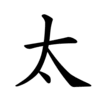太
| ||||||||
Translingual
| Stroke order | |||
|---|---|---|---|
| Stroke order | |||
|---|---|---|---|
 | |||
Han character
太 (Kangxi radical 37, 大+1, 4 strokes, cangjie input 大戈 (KI), four-corner 40030, composition ⿵大丶)
Descendants
References
- KangXi: page 248, character 10
- Dai Kanwa Jiten: character 5834
- Dae Jaweon: page 505, character 1
- Hanyu Da Zidian (first edition): volume 1, page 524, character 1
- Unihan data for U+592A
Chinese
Glyph origin
Phono-semantic compound (形聲, OC *tʰaːds) : phonetic 大 (OC *daːds, *daːds, “big; great”) + semantic 丶 – excessive.
Etymology 1
| simp. and trad. |
太 | |
|---|---|---|
| alternative forms | 冭 | |
A superlative derivative of 大 (OC *daːds, *daːds, “big”) – be too great, very great, excessive.
Pronunciation 1
Definitions
太
- too; so (modifying adjectives; often used with 了 (le) at the end of the sentence for emphasis)
- (usually in negative sentences) very; quite
- 他不太舒服。 [Taiwanese Mandarin] ― Tā bù tài shūfú. [Pinyin] ― He's not very well.
- most; utmost
- highest; greatest
- senior; noble
- Short for 太湖 (Tàihú, “Lake Tai, a lake in Southern Jiangsu, China”).
- Short for 太平洋 (Tàipíngyáng, “Pacific Ocean”).
Synonyms
See also
- 很 (hěn)
Pronunciation 2
Definitions
太
Pronunciation 3
Definitions
太
- † Only used in 太末.
Compounds
|
|
|
Etymology 3
| For pronunciation and definitions of 太 – see 泰 (“big; large; great; extensive; etc.”). (This character, 太, is the second-round simplified form of 泰.) |
Notes:
|
Japanese
Readings
Etymology 1
From Old Japanese.
Synonyms
- (fat person): でぶ (debu)
- (shamisen): 太棹 (futozao)
- (thread): 太糸 (futoito)
Prefix
太 • (futo-)
- added to words describing gods or the emperor or other exalted subjects to denote greatness or excellence
- c. 759, Man'yōshū (book 17, poem 4031); text here
- 奈加等美乃 敷刀能里⟨等其⟩等 伊比波良倍 安⟨賀⟩布伊能知毛 多我多米尓奈礼
- 中臣の 太祝詞言 言ひ祓へ 贖ふ命も 誰がために汝れ
- なかとみの ふとのりとごと いひはらへ あかふいのちも たがためになれ
- Nakatomi no / futonoritogoto / iiharae / akau inochi mo / ta ga tame ni nare
- Reciting the Nakatomi's excellent ritual offering, whose [long] life was prayed for? Yours.
- 奈加等美乃 敷刀能里⟨等其⟩等 伊比波良倍 安⟨賀⟩布伊能知毛 多我多米尓奈礼
- c. 759, Man'yōshū (book 17, poem 4031); text here
- added to regular nouns to denote fatness or thickness
Derived terms
Etymology 2
The Old Japanese 終止形 (shūshikei, “terminal (sentence-final) form”) of adjective 太い (futoi, “fat, thick, big”).[2]
Pronunciation
- IPA(key): [ɸɯ̟̊ᵝto̞ɕi]
Etymology 3
Derived from the root word 大 (ō, “great, big”).
Pronunciation
- IPA(key): [o̞ː]
Etymology 4
From Middle Chinese 太 (thajH). Compare modern Mandarin 太 (tài).
Pronunciation
- IPA(key): [ta̠i]
Usage notes
- Only found in compounds.
Derived terms
- 太陰 (taīn): the moon
- 太陰暦 (taīnreki): the lunar calendar
- 太陽 (taiyō): the sun
- 太虚 (taikyo): the sky
- 太極拳 (taikyokuken): tai chi, taijiquan
- 太空 (taikū): the sky
- 太原 (Taigen): the Chinese city of Taiyuan
- 太古 (taiko): ancient times
- 太鼓 (taiko): a traditional fat Japanese drum
- 太鼓橋 (taikobashi): an arched bridge
- 太鼓腹 (taikobara): a paunch
- 太子 (taishi): the crown prince
Etymology 5
From a colloquial form of 太 in Middle Chinese. Compare the similar corruption in Mandarin 大 (dà).
Pronunciation
- IPA(key): [ta̠]
Usage notes
Only found in compounds.
Derived terms
- 太刀 (tachi): a Japanese longsword
- 太郎 (Tarō): a male given name
References
- 1998, NHK日本語発音アクセント辞典 (NHK Japanese Pronunciation Accent Dictionary) (in Japanese), Tōkyō: NHK, →ISBN
- 1988, 国語大辞典(新装版) (Kokugo Dai Jiten, Revised Edition) (in Japanese), Tōkyō: Shogakukan
Korean
Pronunciation
- (SK Standard/Seoul) IPA(key): [tʰɛ] ~ [tʰe̞]
- Phonetic hangul: [태/테]
Etymology 1
From Middle Chinese 太 (MC tʰɑiH). The "pollock" sense is supposedly from the surname, after a fisherman.
Hanja
Compounds
- 태고 (太古, taego)
- 태고 (太高, taego)
- 태극 (太極, taegeuk)
- 태극기 (太極旗, taegeukgi)
- 태반 (太半, taeban)
- 태백 (太白, taebaek)
- 태백성 (太白星, taebaekseong)
- 태부족 (太不足, taebujok)
- 태상왕 (太上王, taesang'wang)
- 태상황 (太上皇, taesanghwang)
- 태수 (太守, taesu)
- 태양 (太陽, taeyang)
- 태양계 (太陽系, taeyanggye)
- 태양력 (太陽曆, taeyangnyeok)
- 태왕 (太王, taewang)
- 태음 (太陰, taeeum)
- 태음력 (太陰曆, taeeumnyeok)
- 태음태양력 (太陰太陽曆, taeeumtaeyangnyeok)
- 태일 (太一, taeil)
- 태자 (太子, taeja)
- 태자비 (太子妃, taejabi)
- 태조 (太祖, taejo)
- 태종 (太宗, taejong)
- 태초 (太初, taecho)
- 태평 (太平, taepyeong)
- 태평성대 (太平聖代, taepyeongseongdae)
- 태평소 (太平簫, taepyeongso)
- 태평양 (太平洋, taepyeong'yang)
- 태평연월 (太平煙月, taepyeong'yeonwol)
- 태평천국 (太平天國, taepyeongcheon'guk)
- 태학 (太學, taehak)
- 태허 (太虛, taeheo)
- 태후 (太后, taehu)
- 태황태후 (太皇太后, taehwangtaehu)
- 동태 (凍太, dongtae)
- 만사태평 (萬事太平, mansataepyeong)
- 명태 (明太, myeongtae)
- 삼태탕 (三太湯, samtaetang)
- 이태리 (伊太利, itaeri)
- 천하태평 (天下太平, cheonhataepyeong)
- 황태자 (皇太子, hwangtaeja)
- 황태후 (皇太后, hwangtaehu)
Etymology 2
A Korean graphic abbreviation of Chinese 大豆 (dàdòu, “soybean”, literally “big bean”), perhaps attested as early as the eighth century.
Presumably, it was originally used as a logogram for the native Korean word 코ᇰ (Yale: khwòng, “soybean”), without a Sino-Korean reading of its own. At some point—perhaps after the logogramic representation of native Korean words declined following the invention of the Hangul alphabet in the 1400s—it became conflated with the visually identical character 太 (“large; great”) and now shares its Sino-Korean reading, 태 (tae).
Compounds
- 태말 (太末, taemal)
- 태유 (太油, taeyu)
- 마태 (馬太, matae)
- 장태 (醬太, jangtae)
- 청태 (靑太, cheongtae)
- 한시태출 (旱時太出, hansitaechul)
- 흑태 (黑太, heuktae)